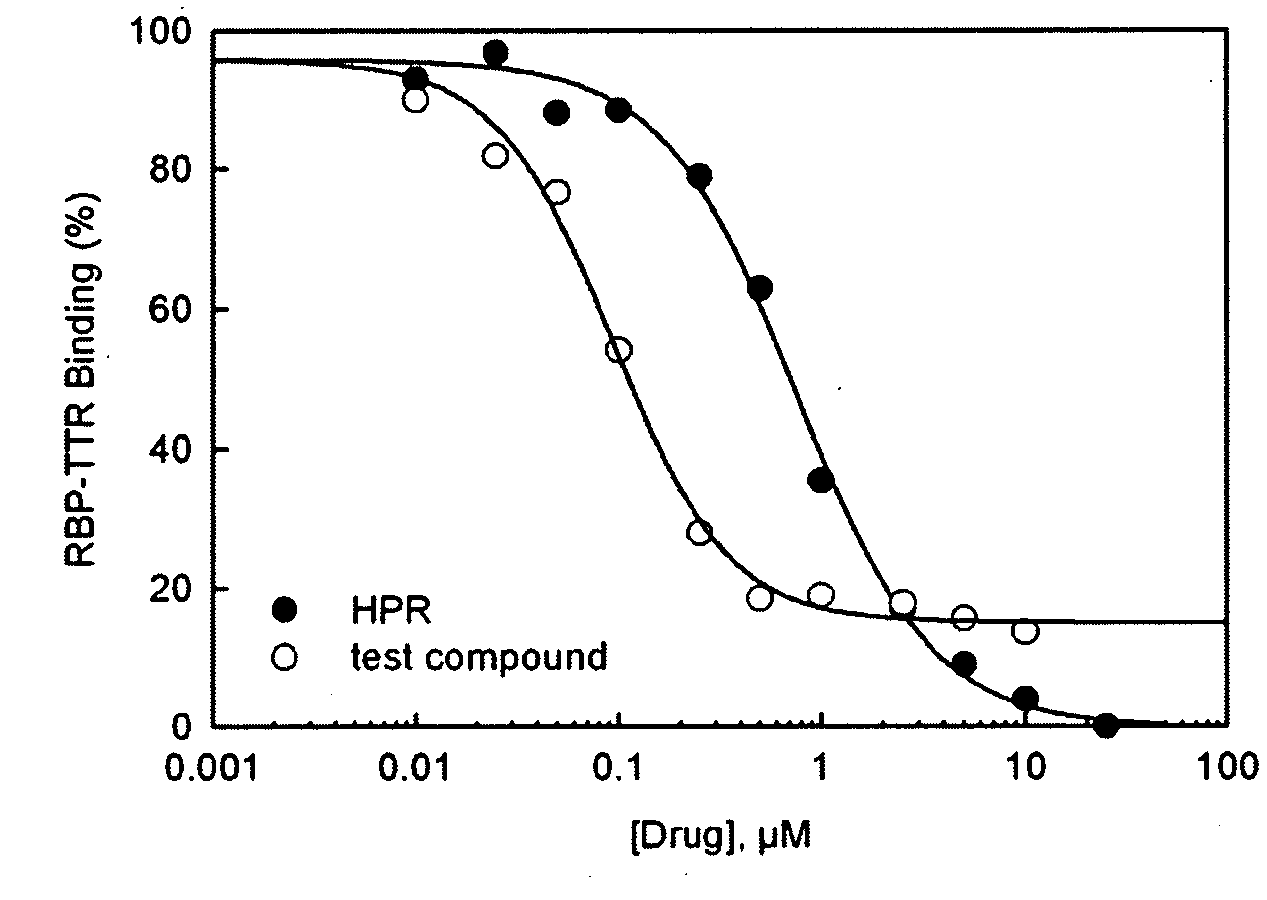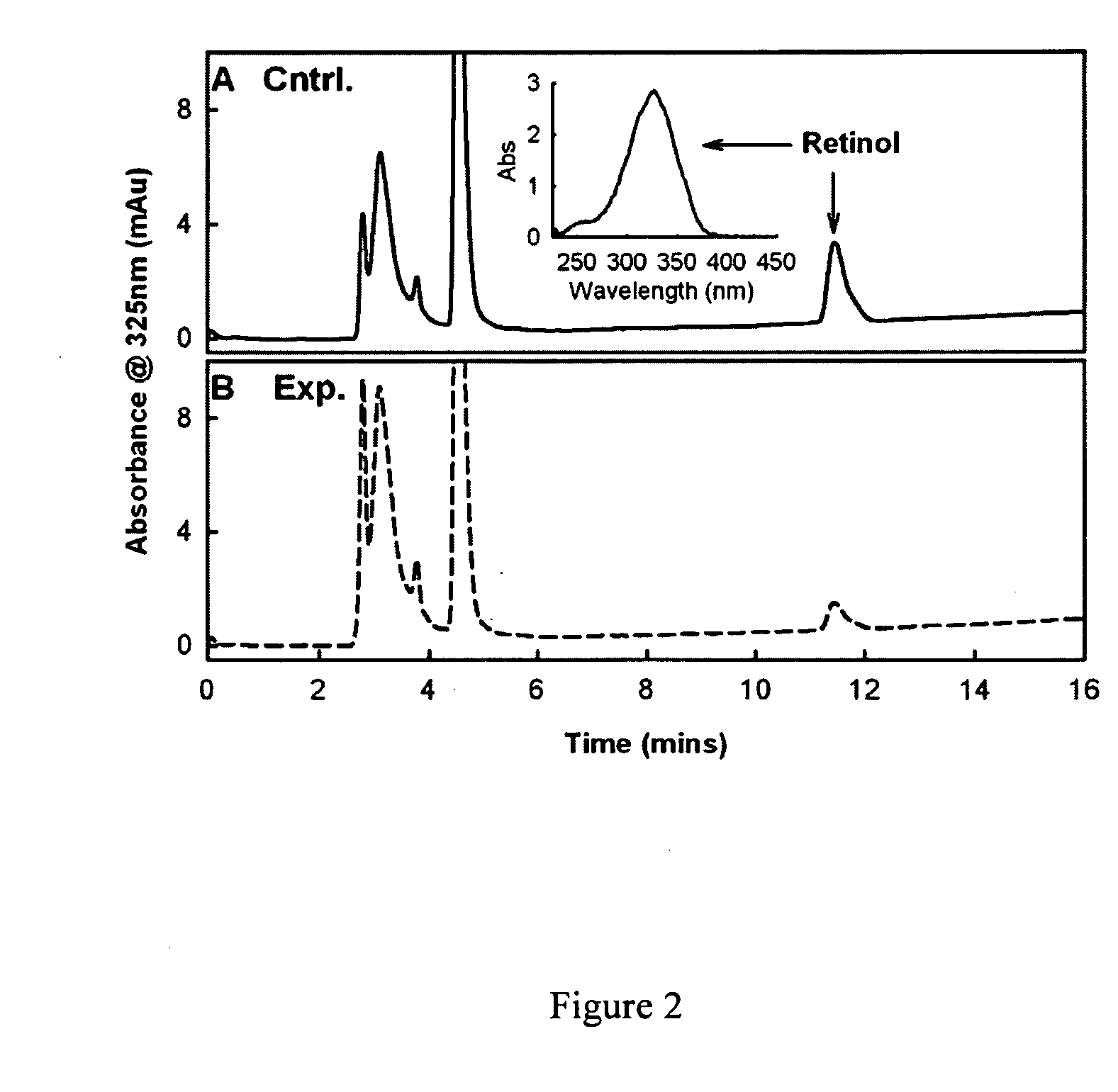Methods and compounds for treating retinol-related diseases
a technology of retinol and retinol, which is applied in the field of treatment of retinol-related diseases, can solve the problems of severe damage to the central vision, gradual loss of vision, blindness and death of children, etc., and achieve the effect of reducing the serum retinol or ocular tissue retinol levels
- Summary
- Abstract
- Description
- Claims
- Application Information
AI Technical Summary
Benefits of technology
Problems solved by technology
Method used
Image
Examples
example 1
Synthesis of 5-(2-tert-Butyl-4-chlorophenoxy)pentanoic Acid
[0582]
[0583]Methyl 5-bromovalerate (1.52 mL, 2.09 g, 10.7 mmol), 2-tert-butyl-4-chloro-phenol (2.4 g, 13 mmol) and potassium carbonate (1.4 g, 10.1 mmol) were suspended in dry DMF (10 mL) and stirred for 2 h at 120° C. To the resulting mixture water was added (80 mL) and extracted with ethyl acetate (3×20 mL). The organic layers were washed two times with 10% sodium hydroxide (2×20 mL), water (1×20 mL), dried over sodium sulfate and evaporated in vacuo. To afford 3.46 g (quant) crude la that was used in the next step without further purification. 1H NMR (400 MHz, CDCl3) δ ppm 7.21 (d, J=2.6 Hz, 1H), 7.10 (dd, J=8.6, 2.6 Hz, 1H), 6.75 (d, J=8.6 Hz, 1H), 3.97 (t, J=5.8 Hz, 2H), 2.46 (t, J=6.9 Hz, 2H), 1.84-1.94 (m, 4H), 1.36 (s, 9H).
[0584]A mixture of la (3.46 g), 10% sodium hydroxide (10 mL) in dioxane (50 mL) was stirred overnight at room temperature. The dioxane was removed in vacuo, the remaining mixture was diluted with w...
example 2
Synthesis of 5-(2-tert-Butyl-4-chlorophenoxy)-N-(4-hydroxyphenyl)pentanamide
[0587]
[0588]A mixture of 1-1 (0.3 g, 1.05 mmol) and carbonyl diimidazole (0.18 g, 1.11 mmol) was stirred in dichloroethane (2.5 mL) for 30 minutes, then 4-aminophenol (0.136 g, 1.25 mmol) and N,N-diisopropylethylamine (220 μL, 1.25 mmol) was added. The resulting solution was stirred for additional 4 h. The solvent was evaporated, the remaining mixture was diluted with 20 mL ether and washed with 1M hydrochloric acid (1×20 mL), the organic layer was dried over sodium sulfate and the solvent evaporated. The product was triturated with diisopropyl ether to give 2-1 (6 mg, 25%).
example 3
Synthesis of Methyl 4-(5-(2-tert-butyl-4-chlorophenoxy)pentanamido)benzoate
[0589]
[0590]A mixture of 1-1 (0.25 g, 0.88 mmol) and oxalyl chloride (0.12 g, 0.95 mmol) in dichloroethane (5 mL) was stirred for 48 h at room temperature. The solvent was removed in vacuo and the residue was dissolved in dichloroethane. To this solution methyl 4-aminobenzoate (0.146 g, 0.96 mmol) and N,N-diisopropylethylamine (350 μL, 2.0 mmol) were added and stirred overnight at room temperature. The mixture was washed with 20 mL 10% hydrochloric acid, the organic layer was dried over sodium sulfate and the solvent was removed in vacuo to give 0.25 g (69%) 3-1. LCMS: method A, Rt: 1.85 min, M+H=418.
[0591]The following compounds were made by the above procedure using either oxalyl chloride or thionyl chloride.
LCMSNo.MWMH+RtMethod3-24184181.85A3-33903901.64A3-44244243.63B3-5424424284B3-64444442.12A3-74164161.84A3-84504501.98A3-94164161.85A3-104584582.14A
PUM
| Property | Measurement | Unit |
|---|---|---|
| pH | aaaaa | aaaaa |
| flow rate | aaaaa | aaaaa |
| molecular weight | aaaaa | aaaaa |
Abstract
Description
Claims
Application Information
 Login to View More
Login to View More - R&D
- Intellectual Property
- Life Sciences
- Materials
- Tech Scout
- Unparalleled Data Quality
- Higher Quality Content
- 60% Fewer Hallucinations
Browse by: Latest US Patents, China's latest patents, Technical Efficacy Thesaurus, Application Domain, Technology Topic, Popular Technical Reports.
© 2025 PatSnap. All rights reserved.Legal|Privacy policy|Modern Slavery Act Transparency Statement|Sitemap|About US| Contact US: help@patsnap.com



